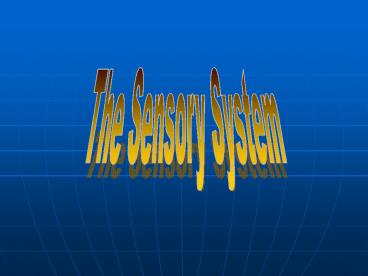The sensory system PowerPoint PPT Presentation
1 / 19
Title: The sensory system
1
The Sensory System
2
- http//www.hhmi.org/senses/a/a110.htm
- Its all in the Brain Illusions reveal the
brains assumptions, sensing change in the
environment, vision, hearing, and smell the
best-known senses
3
The General Senses
- Sensory receptors specialized monitoring cells
- Free nerve endings simplest type, they are
sensory neuron dendrites - Adaptation reduction in sensitivity in the
presence of constant stimulus - RAS in the midbrain, it affects out state of
consciousness
4
- General senses temperature, pain, pressure,
touch, vibration proprioception (body position) - Special senses vision, hearing, smell
(olfaction), taste (gustation), balance
(equilibrium)
5
General sense receptors
- Are simple, found everywhere and are classified
by their stimulus - Nociceptors sensitive to pain
- Thermoreceptors heat
- Mechanoreceptorstouch, pressure,
- Chemoreceptors chemicals
- Their info goes to the primary sensory cortex
only 1 reaches the cortex
6
Thermoreceptors
- Free nerve endings in skin, muscle, liver, and
hypothalamus, they adapt quickly - Cold receptors respond to temps lt50, they are
4Xs as numerous as warm - Warm receptors respond to temps gt113,
- Both receptors are structurally identical
7
Mechanoreceptors
- Membrane distortion opens ion channels to create
impulses.3 classes - Tactile touch
- Baroreceptors pressure
- Proprioceptors body position
- TACTILE receptors simple or complex,
superficial or deep, fine (provide detailed info)
or crude (provide little information)
8
Baroreceptors.
- Stretch receptors (free nerve endings) that
monitor changes in organ pressure (bladder,
lungs, vessels, digestive tract) - Rapidly adapting
- Generate AP from their dendrites when organs are
stretched/change position - They monitor blood pressure, respiration,
digestion, urinary control
9
Chemoreceptors
- Only respond to dissolved chemicals
- Rapidly adapting, found in olfaction, taste the
CNS at - Medulla receptors are sensitive to pH/CO2
changes in CSF triggers resp. adjustments - Aortic/Carotid bodies sensitive to changes in
pH/CO2/O2 blood levels triggers adjustments in
respiration and cardiovascular activity
10
Proprioceptors.
- Monitor joint position muscle contraction
- DO NOT ADAPT
- Structurally complex are 2 types
- Tendon organs monitor tendon strain
- Muscle spindles monitor muscle length
- Most info from these receptors is monitored
subconsciously
11
Olfaction The sense of Smell
- Paired olfactory organs containing receptors,
supporting cells stem cells - olfactory glands produce mucus
- olfactory receptor cells are highly modified
neurons (chemoreceptors) - Pathway olf.epitheliumgtolf.bulbsgtolf.tractsgtcort
ex
12
Gustation.taste
- Taste buds individual organs containing
gustatory supporting cells - Chemicals contact taste hairs which change the MP
of taste cell - 4 primary taste sensations sweet, salt, sour,
bitter - Pathway sensory receptorsgtmedullagt
thalamusgtprimary sensory cortex
13
Vision
- Accessory structures palpebrae, eyelashes
brows, exocrine glands, lacrimal glands,
conjunctiva and 6 occulomotor muscles. - The eye is hallow divided into anterior and
posterior cavities - Its walls are made of 3 tunics fibrous,
vascular and neural
14
Eye anatomy..
- Refer to your dissection lab.
- http//www.hhmi.org/senses/a/a110.htm
- Breaking the Code of Color
- How we see things that move
15
Retinal organization
- Several cell layers
- Photoreceptor cells (rods cones)
- Bipolar cells
- Ganglion cells
- Optic Disc - blind spot
16
Accommodation
- The process of focusing an image on the retina by
changing lens shape - Focusing (producing a clear image)
- light bends/refracts passing from 1 medium to
another - The lens changes shape to keep the image focused
on the retina
17
The Physiology of VisionHow is it that we see?
- Our photoreceptors respond to visible light
- Rods sensitive to photons (energy) but not
their wavelength (color) - Cones- 3 types, sensitive in bright light,
responsive to wavelength they allow us to see
color - Lack of functional cones colorblindness
18
Photoreception
- Light absorption requires rhodopsin a visual
pigment found in the outer segments of the
photoreceptor cells - The process
- Light rhodopson opson activation
enzyme activation NTmitter release - Rhodopson regeneration follows
19
The visual pathway.
- Photoreceptor stimulation
- Bipolar cell activation
- Stim. ganglion cells whose axons form the
- Optic nerve that cross at the diencephalon and
goes to the thalamus that routes info to the - visual cortex of occipital lobe
- reflex centers of brain stem

